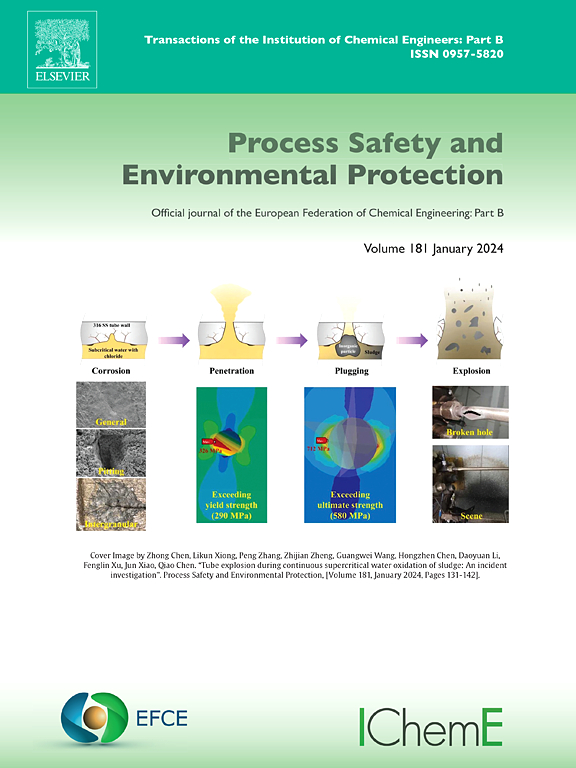使用从农业废弃物中提取的活性炭去除塑料源释放的有毒污染物
IF 7.8
2区 环境科学与生态学
Q1 ENGINEERING, CHEMICAL
引用次数: 0
摘要
塑料污染是一个重大的环境问题,对生态系统、水资源和人类健康产生负面影响。在塑料工业产生的各种污染物中,双酚A (P-BPA)是最常见的污染物之一,在世界各地不同浓度的地表水、地下水甚至饮用水中经常被检测到。本研究提出了一种简单、经济的方法,利用农业废弃物活性炭(AC-AW)及其改性形式(MAC-AW)去除P-BPA。通过扫描电镜(SEM)、比表面积分析(BET)和傅里叶变换红外光谱(FT-IR)分别证实了AC-AW的多孔结构、高比表面积和多种表面官能团。pH 6.0时,对P-BPA的最大吸附量分别为:MAC-AW为238.09mg/g, AC-AW为188.67mg/g。此外,MAC-AW对城市和工业废水中P-BPA的去除率分别为95.8 %和86.1%。经过4次循环使用后,对P-BPA的去除率高达91%,表明农业废弃物活性炭在水处理中的实际应用潜力。此外,还重点介绍了AC-AW吸附塑料源释放的P-BPA的机理、优点和挑战。本文章由计算机程序翻译,如有差异,请以英文原文为准。
Removal of toxic pollutants released from plastic sources using activated carbon derived from agricultural waste
Plastic pollution is a major environmental issue, negatively impacting ecosystems, water resources, and human health. Among the various pollutants derived from the plastics industry, bisphenol A (P-BPA) is one of the most common and is frequently detected in surface water, groundwater, and even drinking water at varying concentrations around the world. This study proposes a simple and cost-effective method for removing P-BPA using activated carbon derived from agricultural waste (AC-AW) and its modified form (MAC-AW). The porous structure, high specific surface area, and various surface functional groups of AC-AW were confirmed by Scanning Electron Microscopy (SEM), Brunauer–Emmett–Teller (BET) surface area analysis, and Fourier Transform Infrared Spectroscopy (FT-IR), respectively. The maximum adsorption capacities of P-BPA at pH 6.0 were determined to be 238.09 mg/g for MAC-AW and 188.67 mg/g for AC-AW. Besides, MAC-AW was able to remove 95.8 and 86.1 % of P-BPA from municipal and industrial wastewater, respectively. It also kept a high P-BPA removal efficiency (91%) after four reuse cycles, suggesting the potential of activated carbon derived from agricultural waste for practical application in water treatment. In addition, the adsorption mechanisms, benefits, and challenges of using AC-AW for removing P-BPA released from plastic sources were highlighted.
求助全文
通过发布文献求助,成功后即可免费获取论文全文。
去求助
来源期刊

Process Safety and Environmental Protection
环境科学-工程:化工
CiteScore
11.40
自引率
15.40%
发文量
929
审稿时长
8.0 months
期刊介绍:
The Process Safety and Environmental Protection (PSEP) journal is a leading international publication that focuses on the publication of high-quality, original research papers in the field of engineering, specifically those related to the safety of industrial processes and environmental protection. The journal encourages submissions that present new developments in safety and environmental aspects, particularly those that show how research findings can be applied in process engineering design and practice.
PSEP is particularly interested in research that brings fresh perspectives to established engineering principles, identifies unsolved problems, or suggests directions for future research. The journal also values contributions that push the boundaries of traditional engineering and welcomes multidisciplinary papers.
PSEP's articles are abstracted and indexed by a range of databases and services, which helps to ensure that the journal's research is accessible and recognized in the academic and professional communities. These databases include ANTE, Chemical Abstracts, Chemical Hazards in Industry, Current Contents, Elsevier Engineering Information database, Pascal Francis, Web of Science, Scopus, Engineering Information Database EnCompass LIT (Elsevier), and INSPEC. This wide coverage facilitates the dissemination of the journal's content to a global audience interested in process safety and environmental engineering.
 求助内容:
求助内容: 应助结果提醒方式:
应助结果提醒方式:


